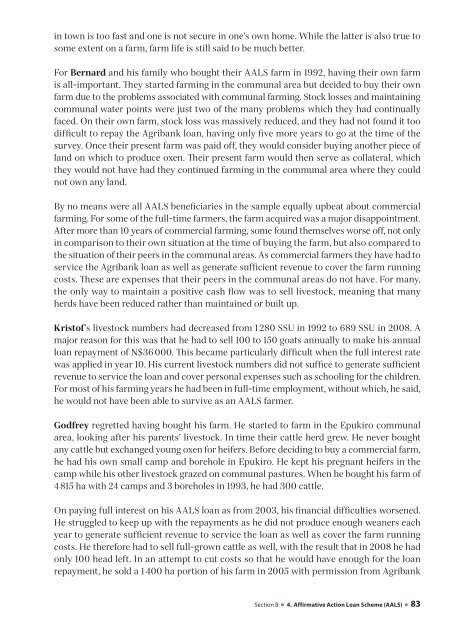Namibia country report
Namibia country report
Namibia country report
- No tags were found...
Create successful ePaper yourself
Turn your PDF publications into a flip-book with our unique Google optimized e-Paper software.
in town is too fast and one is not secure in one’s own home. While the latter is also true tosome extent on a farm, farm life is still said to be much better.For Bernard and his family who bought their AALS farm in 1992, having their own farmis all-important. They started farming in the communal area but decided to buy their ownfarm due to the problems associated with communal farming. Stock losses and maintainingcommunal water points were just two of the many problems which they had continuallyfaced. On their own farm, stock loss was massively reduced, and they had not found it toodifficult to repay the Agribank loan, having only five more years to go at the time of thesurvey. Once their present farm was paid off, they would consider buying another piece ofland on which to produce oxen. Their present farm would then serve as collateral, whichthey would not have had they continued farming in the communal area where they couldnot own any land.By no means were all AALS beneficiaries in the sample equally upbeat about commercialfarming. For some of the full-time farmers, the farm acquired was a major disappointment.After more than 10 years of commercial farming, some found themselves worse off, not onlyin comparison to their own situation at the time of buying the farm, but also compared tothe situation of their peers in the communal areas. As commercial farmers they have had toservice the Agribank loan as well as generate sufficient revenue to cover the farm runningcosts. These are expenses that their peers in the communal areas do not have. For many,the only way to maintain a positive cash flow was to sell livestock, meaning that manyherds have been reduced rather than maintained or built up.Kristof’s livestock numbers had decreased from 1 280 SSU in 1992 to 689 SSU in 2008. Amajor reason for this was that he had to sell 100 to 150 goats annually to make his annualloan repayment of N$36 000. This became particularly difficult when the full interest ratewas applied in year 10. His current livestock numbers did not suffice to generate sufficientrevenue to service the loan and cover personal expenses such as schooling for the children.For most of his farming years he had been in full-time employment, without which, he said,he would not have been able to survive as an AALS farmer.Godfrey regretted having bought his farm. He started to farm in the Epukiro communalarea, looking after his parents’ livestock. In time their cattle herd grew. He never boughtany cattle but exchanged young oxen for heifers. Before deciding to buy a commercial farm,he had his own small camp and borehole in Epukiro. He kept his pregnant heifers in thecamp while his other livestock grazed on communal pastures. When he bought his farm of4 815 ha with 24 camps and 3 boreholes in 1993, he had 300 cattle.On paying full interest on his AALS loan as from 2003, his financial difficulties worsened.He struggled to keep up with the repayments as he did not produce enough weaners eachyear to generate sufficient revenue to service the loan as well as cover the farm runningcosts. He therefore had to sell full-grown cattle as well, with the result that in 2008 he hadonly 100 head left. In an attempt to cut costs so that he would have enough for the loanrepayment, he sold a 1 400 ha portion of his farm in 2005 with permission from AgribankLivelihoods Section after B ● 4. Land Affirmative Reform: <strong>Namibia</strong> Action Loan <strong>country</strong> Scheme <strong>report</strong> (AALS) (2010) ● 83
















